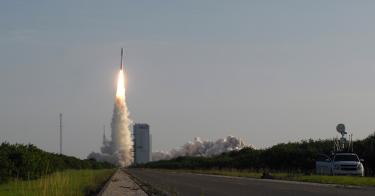Over the last four years, America has come a long way toward regaining the upper hand in space. The Obama era’s timid aspirations and anemic funding for this important domain are largely a thing of the past. Instead, we have an active commercial launch sector, a reinvigorated NASA, and a reconstituted Defense Department.
America led the world in space from the mid-1960s through the end of the Space Shuttle program. But even before the Atlantis flew that program’s last mission in 2011, the decline had started.
President Obama canceled NASA’s Constellation Program—a plan for manned exploration of the moon and then Mars—in 2010. In its stead, he promised to increase NASA’s budget by $6 billion to pursue a rather fanciful asteroid retrieval program. However, he ultimately cut the agency’s budget by more than $11.4 billion over the next six years. It left the nation that had previously led all others to rely on Russian rockets to send its astronauts into space for the next nine years.
The outlook for NASA and the whole of the U.S. space program changed in 2017 when President Trump issued the first of five memoranda to revive American ascendancy in space. It directed NASA to team with private-sector partners for manned missions to the moon and Mars. Program Artemis, as it is called, has thus far received the funding needed to achieve those objectives. If the president’s Fiscal Year 2021 budget is approved, NASA funding will increase by more than 31%, and funding for deep space exploration will have grown by more than 260% since 2016.
This June, U.S. astronauts traveled to space in the first manned rocket launched from U.S. soil since 2011. Artemis is on track to land astronauts on the moon by 2024 and send them to Mars in the mid-2030s.
NASA will rely on commercial space companies to help get there, and it now has many options.
In 2010, only three commercial organizations provided launch services within the United States. That number remained unchanged until the Trump administration issued its second space policy memorandum in May 2018, streamlining commercial space licensing regulations. The results are telling. This year, six U.S. corporations are placing satellites in orbit. They are scheduled to launch a total of 53 missions into space—24 more than have been launched from U.S. soil in any other single year.
Both China and Russia regard routine access to space—and the ability to deny access to others in times of war—as vital components of their national and military strategies. They are scheduled to conduct 22 and 21 launches, respectively, in 2020. Clearly, America has rocketed past its peers with this vital capability.
However, Beijing and Moscow have invested heavily in both ground-based and orbital anti-satellite (ASAT) missile programs to deliver kinetic strikes or alter U.S. satellites' signals or orbits through robotic interference. Those systems have already been fielded, yet, until recently, the United States had not moved to protect our spaceborne systems, much less to develop a warfighting capability in that domain.
In 2017, Congress mandated a review of the organization and command and control of space assets within the Defense Department. Shortly after the results were released, President Trump issued another space policy memorandum directing the establishment of a combatant command and the steps that would lead to sixth uniformed service to focus on the warfighting domain of space. Both Space Command and the U.S. Space Force became realities in December of 2019, giving the Defense Department the footing it needs to protect the other two legs of the U.S. Space Trifecta—our exploration and commercial sectors—and defend the ultimate high ground for the United States and its allies.
The gains made with NASA, the U.S. commercial space sector, and the Defense Department’s space program over the last four years have given America the momentum needed to propel it ahead of its peer competitors. But today’s great-power competition requires continued persistence in all three areas to ensure America’s ascendency in this domain.
The Trump administration has taken extraordinary steps to put the United States on the threshold of leading all other nations in space, and Congress has backed those steps up with commensurate funding. The long-term viability of America’s space program relies on a seamless stream of administrations that support a vision for America’s supremacy in this domain and congressional funding that matches that vision.
This piece originally appeared in Real Clear Defense



